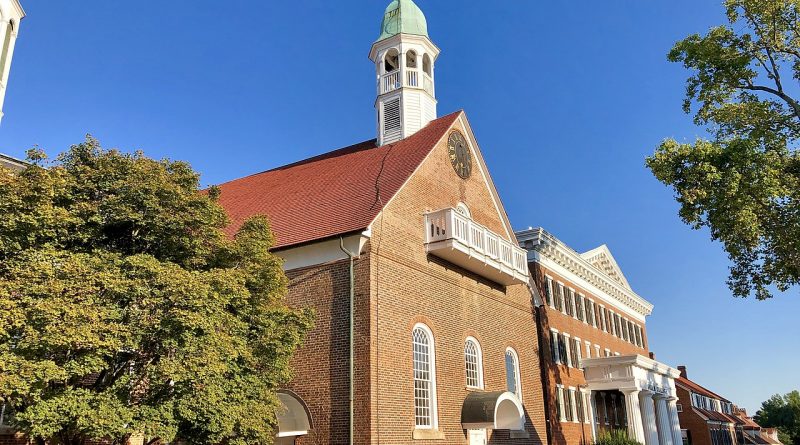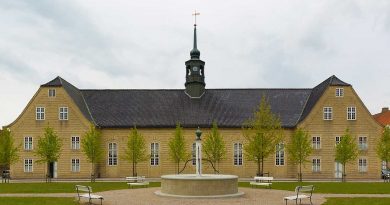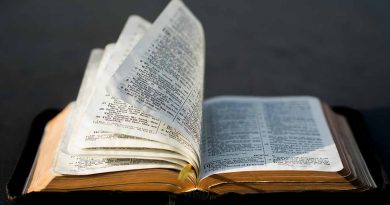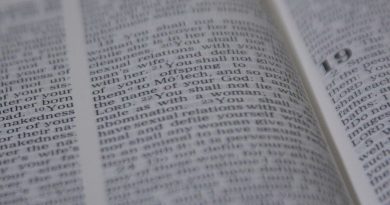A Discernment Process on a Congregation’s Marriage Policy
by the Rev. Ginny Hege Tobiassen
The people of God do their holy work in community. Part of that holy work is making decisions together through community discernment. Discernment is a careful and sacred process, requiring thought, prayer, silence, conversation, and, above all, time.
In November 2018, the Board of Elders of Home Moravian Church entered into a season of discernment about the rite of marriage as it applied to same-gender couples. Recognizing that strong feelings existed on many sides, the board understood that our discernment would be hard work. Like the congregation itself, the board represented a diversity of opinion. Though each member held the Bible dear, we interpreted scripture in different ways. Each member of the board also contributed to and experienced the process in unique ways.
How would these differences affect our conversations? Would they create hard feelings and throw up roadblocks to decision-making? Going into the process, we were not sure what to expect; but what we discovered, over time, was that individual differences contributed to the whole group’s ability to process a variety of information, including scripture, tradition, church polity, personal experience, and the voices of the congregation.
History
In April 2018, the Southern Province Synod passed Resolution 13, acknowledging the church’s differing opinions regarding homosexuality and affirming the right of individuals and congregations to make their opinions known without fear of recrimination. The synod also passed Resolution 14, affirming within the provincial Book of Order the power of congregations to make their own decisions regarding the administration of rites and sacraments.
Resolution 14 encouraged congregations to “engage in continued study, prayer, reflection, and conversation” regarding human sexuality.
Resolution 14 did not require churches to make decisions. The resolution instead encouraged congregations to “engage in continued study, prayer, reflection, and conversation” regarding human sexuality.
Home Church took that encouragement seriously. From June through October 2018, Home Church leadership offered to the congregation a variety of learning opportunities focusing on the Synod resolutions, biblical interpretation in the Moravian church and elsewhere, and the history and meanings of marriage.
As the year moved on, however, members of the congregation began to ask what would happen following these educational opportunities. Would the board would be making any decisions regarding same-gender marriage? In response, the board decided that a process of discernment was necessary.
In November, at the annual church council, the Board of Elders announced that it had entered a period of discernment on the following questions:
- What decisions need to be made regarding the administration of the rite of marriage to our members?
- With whom do such decisions lie?
- What process shall be used for making such decisions?
The board set a six-month schedule for this period of discernment, with the expectation of answering these questions by May 2019.
Honesty, vulnerability, and a willingness to voice one’s convictions were necessary to discernment.
Hearing the Voices
Because the voices of the congregation were necessary to community discernment, the board invited all Home Church members to submit signed letters to the board, expressing their thoughts on same-gender marriage. With the understanding that honesty, vulnerability, and a willingness to voice one’s convictions were necessary to discernment, the board stressed that anonymous letters would not be accepted. In response to the request, the board received 135 letters representing 153 members of our congregation. (Some couples submitted a joint letter.)
The content of these letters was entirely confidential. Only members of the board were allowed to read them, and we were not allowed to discuss them outside of our meetings. Board members were required to come to the church and read the letters in an enclosed room (not a public space).
Reading the letters required hours of commitment and a great deal of emotional energy. Many letters were quite long. Many expressed complex understandings of scripture and tradition. Some revealed deeply personal stories that produced powerful emotions as we read them. All the letters gave us unprecedented insight into the congregation, as individuals and as the Body of Christ.
Every member of the elders read every letter submitted. Every elder was changed in some way by the experience. In reading the letters, we felt we were sitting with the congregation, listening to members’ deepest hopes and fears. We saw what caused them pain and what caused them joy. We learned about their relationship to scripture. Because members wrote letters, the elders came to know the congregation in a new way, and we were grateful. Reading the letters not only prepared the ground for our discernment; it deepened our commitment to the discernment, because it deepened our commitment to the congregation.
Process
Our next step was to develop a process that would honor all of the voices in the letters, as well as each voice on the board. We sought a process to assure that all voices were heard and that no voice was belittled, dismissed, or demonized. Our process sometimes required everyone in the room to speak. Our process always required everyone in the room to listen.
We remained open to the leading of the spirit, and we were often surprised by the results.
Our process included times of silence, speaking, prayer, and devotional study. We did not plan towards a target or particular outcome, as to do so would not have been discernment. Instead, we remained open to the leading of the spirit, and we were often surprised by the results.
It has been said that a problem is something we attempt to solve, while a mystery is something we walk around and observe. The elders approached our discernment as a period of walking around a mystery. Each month, there was more to observe, and we developed new ways of thinking and talking about what we were seeing, until we arrived at a resolution.
Month by Month
December. As we moved into our discernment process, we talked about the important roles of scripture, tradition, and experience. All of us were moved by listening to one another, and the thoughts expressed gave us much to think about in the month to follow.
January. As the letters began to arrive, we reflected on their content. We considered two letters expressing two clearly different points of view, and reflected on what we heard and how we might care for the people with these differing views. We also considered what we might say to encourage people who were hesitant to write letters. We reflected on what voices within the congregation we might not be hearing.
February. We focused on learning to listen deeply and talk honestly with one another. We discussed thoughts and feelings (and the difference between the two) regarding the process of discernment. We asked ourselves: What does the congregation need? What do the elders need? We considered how we were affected by one another’s words, and what we learned from one another.
March. We dove again into the letters, asking:
- Can you remember a letter that was especially meaningful to you? Tell about your experience.
- What is something you learned about scripture from reading the letters? This may be something that you experienced in a new way OR for the very first time.
- What did you learn by reading the letters of those whose positions you disagreed with?
- What is another specific thing that you learned from reading the letters?
We agreed that the letters contained much more than simple “yes” or “no” answers to the question of same gender marriage. We pondered the many voices we had heard in the letters. We tried to name the thoughts and feelings of the congregation by completing the sentence, “I hear a Home Church member saying….”
Emerging from this process was a long list of observations that made clear the love members have for Home Church; the congregation’s unified desire to be a welcoming space; the presence of defensiveness and fear of conflict; and the serious engagement our members had shown in the letter-writing campaign. All told, the list of observations gave us a broad picture of the congregation, how its members were engaging with the issue, and what the elders needed to pay attention to in caring for the congregation as discernment continued.
April. We considered again the three questions presented to the church in November:
- What decisions need to be made regarding the administration of the rite of marriage to our members?
- With whom do such decisions lie?
- What process shall be used for making such decisions?
We discussed the need to understand the values of the congregation, which reading the letters helped us to do. We acknowledged that we had been exploring our own values as well.
We discussed the following questions:
- What does our congregation value regardless of the consequences?
- What do the elders value regardless of the consequences?
- What are some of the values you have heard expressed in the letters?
- Do these values conflict in any way?
We considered that sound values do not conflict, but instead complement one another. We discussed whether we could recognize the complementarity, rather than the conflict, in the values the congregation was expressing.
We understood that our discernment should not be a search for a path of least resistance, but an effort to understand what decision would be consistent with the values of our congregation. We were also searching for what would be healthiest, while recognizing that “healthiest” does not mean “pain free.”
To better understand the concept of congregational health, we considered the example of a healthy tree. A healthy tree would be able to withstand stress; to receive nourishment; to respond to nourishment with growth; and to bear fruit. In our discernment, we were asking: What will help our congregation be strong enough to withstand stress? What are our sources of nourishment and what will help us receive them? Can we respond by growing in faith? What will help our congregation bear fruit—and what fruit will it bear?
We looked again at the questions we were charged with answering in November. There was no clear path to a decision on same-gender marriage, because the polity was unclear. Marriage is not mentioned in the Home Church constitution, nor is there any language about marriage in any of the church’s rules, except that the building use policy permits “members and children of members” to hold weddings at Home Church.
In this meeting, we focused on identifying options for moving forward within our polity, according to the values we understood the congregation to be expressing. We identified every option we could think of; then we evaluated each option (or “proposal”), using the following questions:
- What values does this proposal uphold?
- How does it connect with something you heard in the letters?
- What is the best thing that happens if this proposal goes forward?
- What is the most negative likely effect?
- What concerns you?
The thoughtful work done on these proposals would serve as the basis of the board’s discussion and decision in May.
May. We began by reviewing the history: What decisions, by what bodies in the church, brought us to this point? After this review, we revisited a list of fears we had named in a meeting in July 2018:
- Lingering too long
- Indecisiveness
- Fracturing of community; pulling apart; “can’t keep everyone together”
- Money loss
- Member loss
- Anxiety
Most members of the board still felt at least some fear around these points. We discussed whether anything had made us more or less afraid. In our devotion, we considered the writing of Dr. Michael Brown in the book Bottom Line Beliefs, regarding the nature of the church. Dr. Brown has written that the church remains strong if it remains a place of meaning. In order to remain a place of meaning, it must be a place where people can talk about their faith, practice discipleship, and experience God. We discussed the importance of remaining such a place.
For a period of intercessory prayer, each elder was asked to hold in his/her heart someone in the congregation who had expressed anger, sadness or fear about the decision before the elders. We talked about how to care for these members going forward. We prayed for these and other members.
A clear majority of the board was ready to affirm same-gender marriage at Home Church. However, the dividing issue was a question raised in November: With whom would the decision lie?
After discussing all of the proposals raised in our April meeting, a clear majority of the board was ready to affirm same-gender marriage at Home Church. However, the dividing issue was a question raised in November: With whom would the decision lie? While a church council could give a voice to those who had so far not expressed themselves (for example, those who had not responded to the invitation to write a letter), there was concern that a council might provoke reactive and hurtful words instead of thoughtful discussion. It was pointed out that the elders—having studied the topic for months, listened to the voices of the congregation, and worked intensively in community—were equipped to exercise the spiritual leadership to which they were called. In fact, a number of elders expressed the willingness to take the decision upon themselves as a way to protect the congregation from the wounds they anticipated a church council could bring.
Those who argued against a church council, argued out of love and concern for the congregation; and those who argued for a church council also argued out of love and concern for the congregation. Our goal was the same: to do what was best for Home Church. Our motive was the same: love for Home Church. Yet, pursuing the same goal, with the same motive, we could not reach the same decision.
After hours of discussion, we recessed with plans to reconvene a week later.
In the next meeting, we found that our time apart had raised new thoughts. For one thing, we had realized that our church constitution gives the congregation ready access to a church council. In addition to annual council, the constitution specifies that 10 percent of the resident membership can request and be granted a church council at any time. This being the case, the elders did not need to decide whether to call a council for voting on marriage, because the decision to call a council lies in the hands of the congregation.
Next, it was observed that none of our church’s documents (church constitution, Southern Province constitution, Southern Province Book of Order, HMC building use policy) gives explicit authority to the Board of Elders to make decisions about marriage. The provincial constitution (on which all congregations’ constitutions are based) does give authority to the elders regarding building use. Because this authority is spelled out for elders, some congregations bring wedding requests to the Board of Elders for approval. However, the Home Church building use policy specifies that weddings for members and children of members may be approved by staff without board approval.
It was therefore proposed that the board issue a resolution explaining our polity and stating that decisions on all marriages remain in the hands of the Home Church pastors.
A board decision on behalf of the congregation might be challenged because it was not supported by our polity. It was therefore proposed that the board issue a resolution explaining our polity and stating that decisions on all marriages remain in the hands of the Home Church pastors.
The board’s chief concern was that leaving the decision with the pastors on a case-by-case basis would make the pastors the focus of negative reactions. Board members asked the pastor whether this would be an undue burden on herself and the associate pastor. The pastor responded that she would endorse the statement only if the board expressed a strong and clear affirmation for extending the rite of marriage to all members of Home Church. The board voted with a strong majority to express that affirmation. The board then voted to create the proposed resolution and issue it to the congregation.
As the board turned to composing the resolution, it was proposed to include a “majority opinion” and a “minority opinion.” While normally the board speaks with a single voice when issuing decisions, the strength of opinion in this matter—based on each individual’s reading of scripture and church polity—suggested a need for differing voices to be acknowledged. The board agreed and divided into two groups to compose the following “majority” and “minority” paragraphs:
A majority of the elders strongly believe that same gender marriages should be affirmed at Home Moravian Church. Our strong beliefs grow out of our conviction that God did not cease to reveal God’s self to us after the Bible was completed. God continues to reveal God’s self through the Holy Spirit (John 16:13). We desire to be a community that follows in the example of Jesus: one that embodies compassion, love, inclusion, and welcome; and we continue to discern the Holy Spirit’s leading as we together seek to live “in essentials unity, in nonessentials liberty, and in all things love.” We affirm the extension of the rites and sacraments of the church to all of our members.
A minority of the elders believe strongly that same gender marriages should not be held at Home Moravian. The reasons we feel strongly are (1) that as we interpret Scripture, the Bible speaks against homosexuality and therefore we should not allow same gender marriage at Home Church; (2) that both the Bible and the Moravian Covenant for Christian Living affirm marriage only between one man and one woman; and (3) Resolution 44 of the Unity Synod (paragraph 819 COUF) clearly states that “Christian marriage is between a man and a woman.”
We elders acknowledge one another as faithful Christians with differing beliefs, striving to live together in community.
These paragraphs were included in the board’s final resolution, which also included a strong affirmation for extending the rite of marriage to all members. The board then voted to issue the resolution. Consensus was complete, and there were no votes against issuing the resolution. After sending the resolution to the church administrative assistant with directions to email it that night to the congregation, the board closed the meeting with prayers and adjourned.
Afterword
In Acts 10, Peter experiences a vision in which God opens his eyes to a new possibility—an idea that first upsets him, then puzzles him, then at last expands his understanding of the kingdom of God. But the leaders of the church question his understanding—because they have not experienced his vision. And so, the text tells us, “Peter began to explain it to them, step by step” (Acts 11:4).
We learned to share deeply, listen hard, and walk around a mystery until we arrived at a resolution together.
In our discernment process on marriage, the Home Church elders experienced a step-by-step process that helped us to experience one another’s vision. Beginning (and even ending) with very different ideas, we learned to share deeply, listen hard, and walk around a mystery until we arrived at a resolution together. Sometimes we were upset; sometimes we were puzzled; but ultimately, we learned something about living together in the kingdom of God.
In the fall of 2019, the congregation did take up our board’s resolution on marriage within a church council meeting. By a strong majority, the council voted to affirm the work of the board. Even some members who did not agree with the content of the resolution expressed appreciation for the process and affirmed the board’s leadership and decision-making.
However, the experience of council brought to mind a point that elders had discussed: that without the study, listening, prayer and intensive work in community that the board had experienced, a council conversation on this topic could veer into hurtful territory. As a congregation, we did experience pain in that church council, and some of that pain has lingered, to the elders’ sorrow. The experience of our 2019 council affirms the importance of thorough discernment for any church engaging with an emotionally and theologically sensitive issue. Church is relationship, and relationship runs on conversation, and conversation is healthier when it is supported by an extended, careful, step-by-step discernment process.
In the practice of our faith there will always be elements on which we disagree. But, thanks be to God, our agreement is larger and deeper: for we agree that Jesus is Lord.
In the practice of our faith there will always be elements on which we disagree. But, thanks be to God, our agreement is larger and deeper: for we agree that Jesus is Lord.
Hold your thumb and finger an inch apart: we disagree on this much. Spread your hands wide: We agree on this much. This hand gesture became a sort of signature among the elders as we described our differences and our unity.
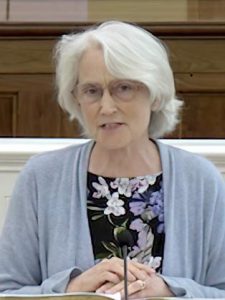
We believe that Christ himself stands with hands spread wide, inviting us all to remain in the body of Christ where we hold so much in common. In this body let us talk to one another; let us grow more deeply to love one another; and let us be grateful for one another and for the Lord we love.
The Rev. Ginny Hege Tobiassen is pastor of Home Moravian Church in Winston-Salem, NC.

